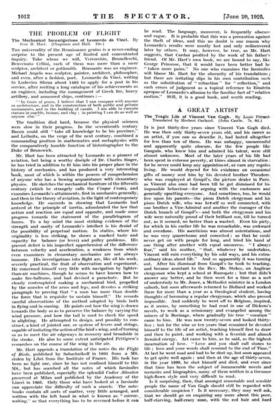THE PROBLEM OF FLIGHT
The Mechanical Investigations of Leonardo da Vinci. By Ivor B. Hart.. (Chapman and Hall. 16s.) TI1E universality of the Renaissance genius is a never-ending
surprise to the present age of limited and concentrated inquiry. Take whom we will, Verrocehio, Brunelleschi, Benvenuto Cellini, each of them was more than a mere sculptor, architect or goldsmith. Bramante was an engineer.
Michael Angelo was sculptor, painter, architect, philosopher,
and even, after a fashion, poet. Leonardo da Vinci, writing to Ludovico Sforza. about 1483 to apply for a .post in his
service, after reciting a long catalogue of his achievements as an engineer, including the management of Greek fire, heavy artillery, and armoured ships, continues :—
"` In times of peace, I believe that I can compare with anyone in architecture, and in the construction of both public and private monuments, and in the building of canals. I am able to execute statues in marble, bronze, and clay ; in painting I can do as well as anyone else.'"
The tradition died hard, because the, physical sciences were slow in their progress. In the seventeenth century Bacon could still " take all knowledge to be his province,". and Leibnitz, on the verge of the next century, combined a commanding position in mathematics and metaphysics with the comparatively IMmble function of historiographer to the . . Duke of Brunswick.
Mr. Hart has been attracted by Leonardo as a pioneer of aviation, but being a worthy disciple of Dr. Charles Singer, he has tried in addition to fit him into his proper place in the history of mechanics, and has produced a very interesting book, most of which is within the powers of comprehension of anyone who has a bowing acquaintance with elementary physics. He sketches the mechanical furniture of the fifteenth century (which he strangely calls the Cinque Cento), and examines Leonardo's attainments, first in mechanics generally, and then in the theory of aviation, in the light of contemporary
knowledge. He succeeds in showing that Leonardo had arrived at the principle of inertia, adumbrated the law that action and reaction are equal and opposite, and made some progress towards the statement of the parallelogram of forces. To a lay mind the most striking evidence of the strength and sanity of Leonardo's intellect is his denial of the possibility of perpetual motion. In statics, where his originality is less striking, he shows a marked taste and capacity for balance (or lever) and pulley problems. His gravest defect is his imperfect apprehension of the difference between velocity and acceleration, a weakness from which even examiners in elementary mechanics are not always immune. His investigations into flight are, like all his work, severely practical, the fruit of observation and experiment. He concerned himself very little with navigation by lighter- than-air machines, though he seems to have known how to make fire-balloons, and had devised a parachute. But he clearly contemplated making a mechanical-- bird, propelled
by the muscles of the arms and legs, and devotes a striking paragraph to proving that " a man has more than double the force that is requisite to sustain himself." He records careful observations of the method adopted by birds both in flying and in soaring. He points out how the wing is drawn towards the body so as to preserve the balance by varying the wind pressure, and how the tail is used to check the speed in alighting. He attempted to design, and possibly to con- struct, a kind of jointed oar, or system of levers and strings, capable of imitating the action of the bird's wing, and of turning so as to meet the air edgeways in recovery and broadside in the stroke. He also to some extent anticipated Pettigrew's researches on the course of the wing in the air.
Mr. Hart appends a translation of the notes On the Flight of Birds, published by Sabachnikoff in 1893 from a MS. stolen by Libri from the Institute of France. His task has been no light one, since he has not confined himself to this MS., but has searched all the notes of which facsimiles have been published, especially the splendid Codice Atlantico preserved at Milan and published by the Academy of the Lincei in 1903. Only those who have looked at a facsimile can appreciate the difficulty of such 'a search; The note- books contain all sorts of matter, very little arranged, and
written with- the left hand in what is known as mirror-__ writing," so that everything has to be reversed; before it can be read. The language, moreover, is frequently obscure and vague. It is probable that this was a precaution against the theft of ideas, and this no doubt is one reason why Leonardo's results were mostly lost and only rediscovered later by others. It may, however, be true, as Mr. Hart suggests, that Cardan profited by the work of his father's friend. Of Mr. Hart's own book, we are bound to say, like, George Primrose, that it would have been better had he taken more pains." No one who examines the facsimiles will blame Mr. Hart for the obscurity of his translations ; but there are irritating slips in his own contribution such as the substitution of " refraction " for " reflection," and such errors of judgment as a topical reference to Einstein apropos of Leonardo's allusion to the familiar fact of "relative motion." Still, it is a good book, and worth reading.










































 Previous page
Previous page